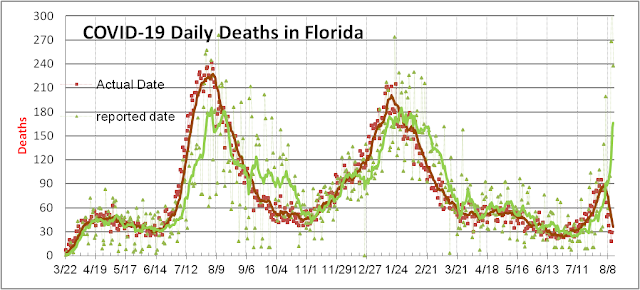Living with Covid-19 is Living Dangerously
Living with COVID-19 has become the catchphrase of the Pandemic recently even though the WHO warns that it is too early to relax our vigilance. Pandemic weariness has taken hold and many people just want to resume “normal” life. Moreover, some countries that have experienced the more contagious but milder Omicron variant and survived its strain on their hospital systems have encouraged others to think that they might also be able to manage the crisis just as well.
What are reasonable benchmarks to use to mark
the transition of a pandemic to endemic phase that society can live with? One benchmark is seasonal flu which can kill
20k-30k Americans, and 300k-600k globally each year. Countries have built enough hospitals and
have enough healthcare resources to handle such outbreaks each year without
shutting down their economies. In the US 30M Americans
develop symptoms of seasonal flu each year and 30k die so a case fatality rate (CFR
= deaths/cases = 0.1%) seems to be acceptable.
If this number dies over a period of 6 months, a mortality rate of
30,000/180/334 = 0.5 per million population per day, or 8 hospital admits per
million pop per day are other equivalent benchmarks.
In early 2020, COVID-19 CFR for many countries
approached 10% and hospitals were overwhelmed causing a lot of unnecessary
deaths. Countries are now doing better
with vaccines and therapeutics that have reduced the effective CFR for COVID-19. At one extreme is Denmark which is 81%
vaccinated and 60% boosted. They removed
all mitigation measures for COVID-19 on February 1st and are
allowing the Omicron variant to infect everyone. 32% of all Danish have already been infected
by the SARS-CoV-2 virus. Being highly
vaccinated they had survived the Delta variant well with a lagged CFR (= deaths/cases
20-day lag) of 0.30%. Omicron, being
more contagious, has infected and killed more Danes but with a CFR = 0.10% they
feel they can now treat COVID-19 as endemic rather than a pandemic. As long as they continue to collect detailed information by age and other demographic dimensions to advise and protect the vulnerable this may be a path to "normality". If new variants including the BA.2 turn out
to be more problematic, they should be prepared to reimpose restrictions.
Other countries have had mixed success in living with
Delta and Omicron (see table below where we list all major countries where Omicron
has been dominant for the last 4 weeks).
The UK has reduced their CFR for Omicron to 0.22% and essentially
dropped most of their restrictions last week even as thousands of Brits are still dying
each week. Australia, after 18 months of
tight restrictions started to loosen up in mid-2020 just as the Delta variant
hit. Its high vaccination rate kept its
CFR at 0.71%. Late last year when
the Omicron hit, cases soared but high vaccination and booster rates lowered the
CFR to 0.14%, even as more Aussies have died in the Omicron wave (1,918) than
the Delta wave (1,101). Spain and France
have also fared reasonably well with the Omicron given their high vaccination
and booster rates. They may follow
Demark in loosening restrictions soon.
Where does the USA stand in this changing landscape? The US had a very high CFR= 1.47% through the 5
months of the Delta wave. With more vaccinations, boosters, and better therapeutics
it has improved the CFR to 0.48% for Omicron but it is still far too early for the
US to consider COVID-19 as endemic.
Vaccination and booster rates need to improve more. With an Omicron death rate of
6.4/day/million, it is much higher than it was for the Delta wave, 3.6, and remains
one of the highest in the world. Omicron
in the US is still 10X more deadly than seasonal flu.




Comments
Post a Comment